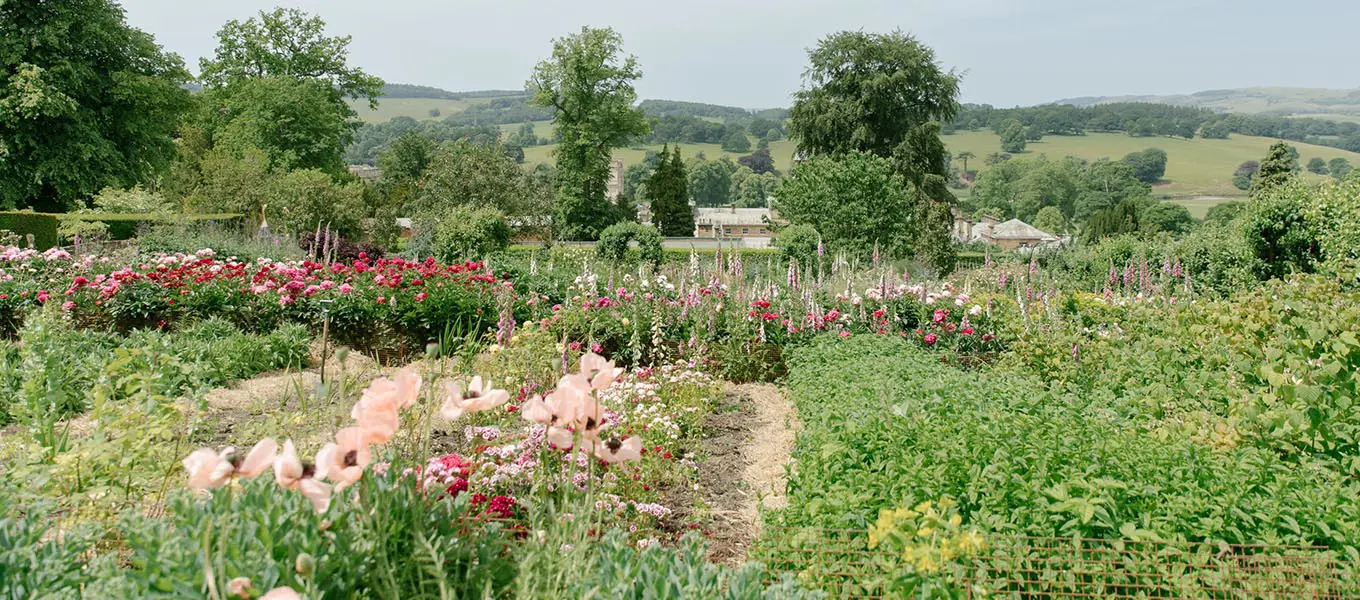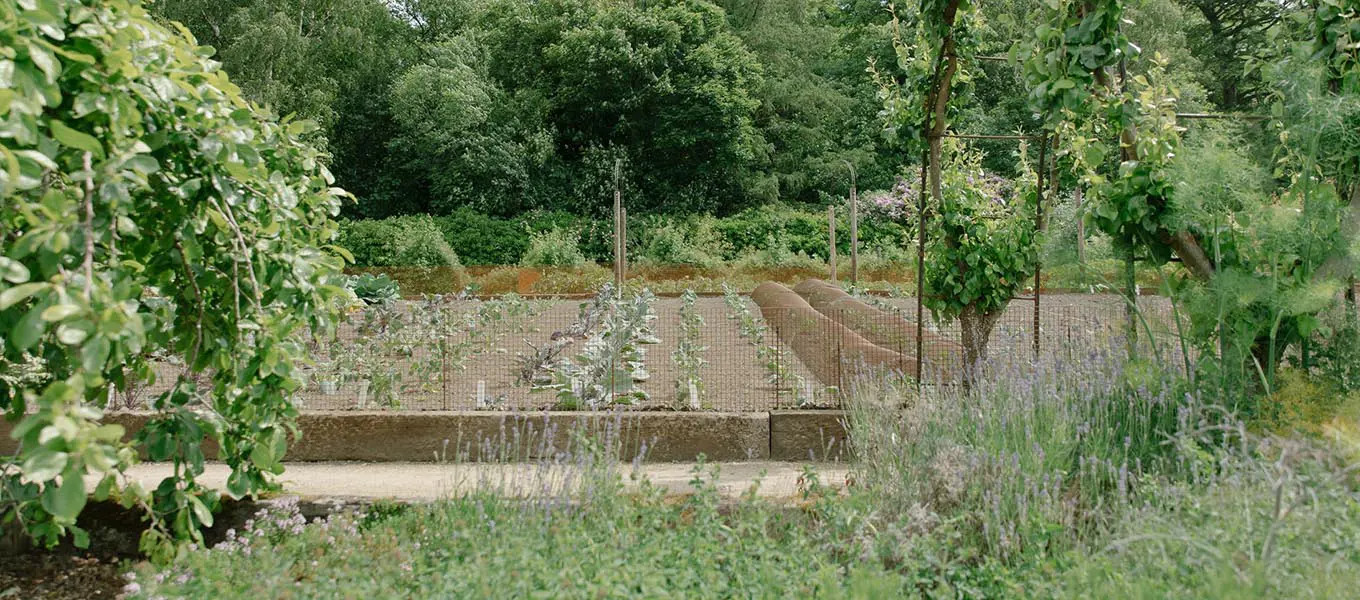A slow start
The cold start to the summer season has meant many of our plants have been slow coming into growth this June. There’s been difficulty germinating many of our seed grown crops and the slugs have certainly got a voracious appetite at the moment, they’ve been devouring a range of our seedlings as soon they’ve been planted out. It’s some consolation knowing that it’s not just happening to us though, many of the keen, gardening visitors we speak to are sharing the same fate this year.
After three sowings of French beans and very few to show for Stefan’s efforts, we’ve decided to forego them in the ground this year, we may still try a few in large pots though. Luckily the peas are romping away as are the potatoes and, despite the slow start, Glenn is still harvesting a good range of produce, including tomatoes, cucumbers, globe artichokes, sugar snap peas and a range of fresh salad leaves.
We’re still able to pick a reasonable amount of rhubarb and it’s heartening to see the gooseberries and currents swelling and colouring up. We hope that in a couple of weeks, along with the summer fruiting raspberries, we’ll be able to start picking them all along with the first of the potatoes.

Acclimatisation
Except from in the far north of the country, the danger of late frosts pass with the advent of June. Plants that are not hardy – such as dahlias, pelargoniums, the summer bedding and many of the exotics we overwintered for the Tropical Borders have been hardened off and can safely be planted out now.
As mentioned in last month’s blog, this process is important to ensure the tender and recently protected specimens become acclimatised to the conditions they will soon experience once planted in their new homes outdoors. These plants need to be able to tolerate a wider range of temperature fluctuations, cope with higher and more intense light levels and be able to deal with the desiccating effect of increased wind exposure by gently introducing them to these new environmental conditions.
Some of our indoor plants, particularly the larger succulents are beginning their summer holidays in sheltered spots outside the glasshouses where they will benefit from improved sunlight and airflow.
While some of these exotic looking plants could, with careful siting and a bit of protection, be grown outdoors all year, there is a chance they will be killed from winter waterlogging.
As many of our specimens are now quite large and important to us, we choose to lift them in late October and over winter them in a cool greenhouse, planted in a free draining compost to be on the safe side.

Herbaceous borders
In the herb borders in the Kitchen and Cutting Garden, sage, rosemary, thyme, mint, fennel, chives, parsley, bay, marjoram, coriander, basil, sweet cicely, lemon balm and loveage have filled out and are gently merging.
At the moment, the chefs in the estate kitchens are taking bundles of these each week and, as the growth ripens and many begin to flower, they also provide choice stems for our team of florists to use in their bouquets and vase arrangements.
Regular clipping will help to prevent the plants becoming leggy and will promote new fresh growth for culinary use over the next few months.
Here is a rough guide for getting the best from your herb plants, which we hope you'll find helpful:
- Mint often becomes straggly at this time of year and will get mildew if too dry at the root. If this happens, it should be watered well and cut back to the ground to encourage it to bush out again with healthy regrowth.
- Basil will often bolt and flower in the hot summer months if not given a bit of regular care. Cutting the stems back to two or three pairs of leaf shoots will get rid of tired leggy growth and encourage it to bush out. You can do this quite regularly throughout the summer and into autumn.
- Chives are best cut hard back after flowering to encourage new growth. To encourage a few new plants, you could gather the seeds and scatter them around beforehand. We’ve edged the length of the potato beds from seed weed collected over the last few years.
- Thyme is flowering beautifully at the moment but will become untidy as the blooms fade. To tidy and keep the plants compact, its best to lightly pruned/clipped after they have flowered. To prevent the plants becoming too woody, cut back the oldest looking stems by two thirds but leave younger stems.
- Rosemary only needs to be pruned if you feel it’s getting too large. Cut stems by no more than a third to keep it tidy. Long straight stems are also good for flower arranging if you have a good supply of them.
- Oregano, marjoram and tarragon can be cut right back once they start to flower. They’ll come back again really quickly, within a week or so. Oregano and marjoram seed freely for us and when in flower are a great food source for bees.
- Sage doesn’t need much pruning at this time of year but we do tidy though them regularly, picking off the old leaves to encourage new growth. We do also use some of the straighter pieces for flower arranging.

Plugging the gap
In the flower garden, the ‘June Gap’, the period between the spring blooms fading and the summer ones reaching their zenith, means a lack of flowers making it a tough time for pollinators and garden florists.
Each year Sophie anticipates this and propagates a range of plants to plug the gap. Some of her favourites are Foxgloves, Aquilegias, Lupins, Camassia, Angelica, Sweet rocket, Thalictrum and Geums. She’s has also planted some flowering shrubs such as, Deutzia, Philadelphus, Flowering Dogwood and Weigela to help out and give structure to her flower beds.
Our potted plants and container arrangements have enjoyed the recent warm spell and starting to romp away. The ground has been cold until now so newly planted stock is still trying to establish itself and put on root mass in the ground.
Peony season
June heralds peony season in the Cutting Garden and around the Maze and there is always a buzz of excitement in the floristry room as these beautiful blooms are loved by the floristry team and visitors alike.
Standing tall and poised, plump buds are teasing us gently as they’ll soon bring a much-appreciated blaze of colour to the flower beds. The peonies grown here include the popular cutting variety, Sarah Bernhardt, a prolific flowerer bearing huge ruffled blooms and Bowl of Beauty, highly scented with dainty anemone like pink-tinted petals.
Chatsworth is also home to others less commonly seen as cut flowers. There are over 40 varieties in the Cutting Garden alone, including a rare, old cultivar called ‘Duke of Devonshire’. Some of our other A-list celebrities include the classic Shirley Temple, a stunning white double with fabulously ruffled centre petals; Dr Alexander Fleming, a beautiful deep pink flowering double with a fantastic fragrance; Duchesse De Nemour – whose huge soft white blooms are delicately scented and simply perfection. There are many more of these paeony lactiflora - Evening World, Coral Charm, the list goes on.
Each one fabulously flowers in its own way and often yields fantastic foliage that changes through the seasons. From the first early red shoots, through deeply cut glossy green leaves to the wonderful red, orange and brown tones of autumn this foliage gives them a much longer season of interest than they are often credited for.

Above: a previous year's display of peonies
Watering tips
Watering through the summer months is a regular and important task and for some things this needs to be daily particularly if the weather stays consistently hot for a while.
Watering properly is not a simple as it sounds, there is a garden adage which goes something like. ‘’If you’re going to water, do it thoroughly or not at all’’.
Watering more comprehensively, but less frequently helps get the water down to the deeper root tips and ensures that the compost around the root balls of container grown plant doesn’t become hydrophobic making it difficult to rewet and hold water .
It’s best to water the garden before drought sets in to keep the soil moisture levels even and avoid the soil around the plant roots completely drying out. It is also important to remember the soil doesn’t have to be really wet all of the time because plants roots need air as well as water to grow well.
Where plant roots are restricted, for example in containers, more frequent and thorough watering and feeding may be needed as the roots are extracting water from a smaller volume of soil than if they were growing freely in the ground.
For our larger pots we feed every other watering and each watering make sure ever container gets at least one full watering cans worth.






